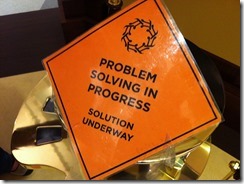
This article has been updated please visit “Brain Injury – Strategies for Organisation, Planning and Problem Solving”
At times we all have trouble trying to work out how to solve a problem. Times when we can’t seem to make a decision. Or we make a decision and then think “Why did I ever do that”.
Brain Injury particularly when it involves the frontal lobe, commonly results in similar difficulties with working through problems, and making good decisions.
The difference is the difficulty problem solving after brain injury might not go away.
A little disclaimer here. Talking separately about cognitive (or executive) functions is not entirely sensible as everything the brain does is linked. I am going to go against my own good advice and do it anyway.
Decision Making and Problem Solving after Brain Injury: What Can Happen?
Problem solving and decision making difficulties after brain injury will be different in each person.
One person might leap to a solution without considering the facts, another might not be able to work out how to solve a problem without a lot of help, someone else may not be able to make a decision at all.
Behaviour may be affected. Working out how to solve a problem, and how to make good decisions enables us to modifiy or adjust our behaviour so we respond appropriately in different situations.
Even though this topic is about problem solving and decision-making it can be helpful to consider the range of outcomes from brain injury. Looking at how each outcome might affect problem solving.
Memory loss might affect problem solving ability because of a difficulty remembering how a similar problem has been resolved in the past. Impulsivity might affect decision-making because decisions are made quickly without thinking them through.
Some common difficulties you may see include:
- Not being able to work out right from wrong.
- Finding it difficult to recognize there is a problem.
- Difficulty working out why something has gone wrong.
- Finding it difficult to anticipate potential problems.
- Making mistakes over and over and not being able to figure out what is causing the mistake.
- Taking a long time, or not being able to make a decision.
- Not able to come up with and use different strategies to solve problems. Or to think creatively and come up with new ideas.
- Not being able to weigh up the pros and cons of each choice or alternative.
- Difficulty reasoning or being able to understand different points of view.
[box]‘Alan’ was a builder and was having trouble putting kit furniture together for his new home. He was becoming frustrated because he knew prior to his brain tumour he could do this without thinking. He found the furniture was not coming together correctly but he could not work out why. He could not seem to work out the possible ways to fix it.[/box]

Tips and Suggestions
Find a simple, consistent process for managing problems. Make sure the process is:
[unordered_list style=”tick”]
- easy to use for the kinds of decisions or problems faced.
- suits the person, their skills and lifestyle
- helpful when prioritising problems [/unordered_list]
Look for a way that suits the person, enabling them to implement the process. This might include one or a combination of techniques such as :
- Writing information down as much as possible. The steps to solve a problem; ideas from other people on the problem, and possible solutions; decisions that have been made.
- Role playing problem solving and decision-making. Taking the part of the other person to work through how
- Talking through the steps agreed for problem solving and decision making.
- Using visual aids such as using a chart, phone app or a set of pictures.
- As much as possible ensure a consistent approach from everyone involved
[box]Alan and his worker Jim talked about how Alan best learned new things and followed instructions. They decided that a picture chart was best as Alan was not a great reader.[/box]
It can be helpful to work out the key questions that need to be asked, and steps needed in the process you decide upon:
A series of questions (tailored to suit the person) might include:
- What is the most important problem right now? If more than one try and pick the one that is a priority. Working on more than one at a time may only increase the difficulty.
- What are all the possible solutions?
- And what are the pros and cons of each solution?
- What is the best solution? What will work best for this problem?
- Step by Step: What is the plan to put the solution into practice?
- And later – How did it work?
[box]Alan’s worker Jim took the kit instructions from the furniture pack and made a simple flow chart with pictures to show the steps and what to do if things went wrong. He included a prompt to stop and think before doing anything further when the building went wrong. They both then worked through the chart together, stopping whenever a problem arises to talk it through.[/box]
Some tips to assist decision making:
- Provide clear guidelines about what is acceptable.
- It may help to work through making the decision together. Weigh up the options and consequences of each then help make the best action or response.
- Be patient and give the person the time, and assistance they need
- Try to ensure decisions, particularly important decisions, are made when conditions that affect behaviour are present such as fatigue.
- If making decisions or choices is very difficult it may be better to give only a limited number of choices – the number that is most easily managed.
- Try to minimize having to make quick, or crisis or last-minute decisions.
As a supporter you can further help decision making and problem solving after brain injury by:
- Giving positive feedback when problem solving skills are used well.
- Keeping track of what is difficult along with any ideas to make it easier. Note what works and in what circumstances.
- Practice how to reason, how to identify problems, and how to work through solutions (using the agreed problem solving approach).
- Give consistent prompts and reminders of what needs to be considered to make decisions and solve problems.
- Support and encourage the person to ask for help when they are planning.
- Explain mistakes clearly and simply, without judgement or anger. Emphasise clearly the link between cause and effect.
- Structured support may be needed while relearning or for the long term,to manage complex tasks or situations, for example the assistance of a support worker or volunteer.
- Further ideas and tips can be found in this article Simple Tips on Decision Making When Life is So Indecisive After Brain Injury
And Finally
Ongoing repetition, practice and consistency will likely be needed to enable the problem solving and decision making to be learned.
All of this works best when everyone involved works together – family, the person living with brain injury, supporters.
If you know of any great resources or strategies for supporters or people living with brain injury please share in the COMMENTS below or send me a note HERE.


Pingback: Brain Injury Difficulty Problem Solving and Planning - Changed Lives New Journeys
Pingback: Strategies for Organisation Planning and Problem Solving After Brain Injury - Changed Lives New Journeys